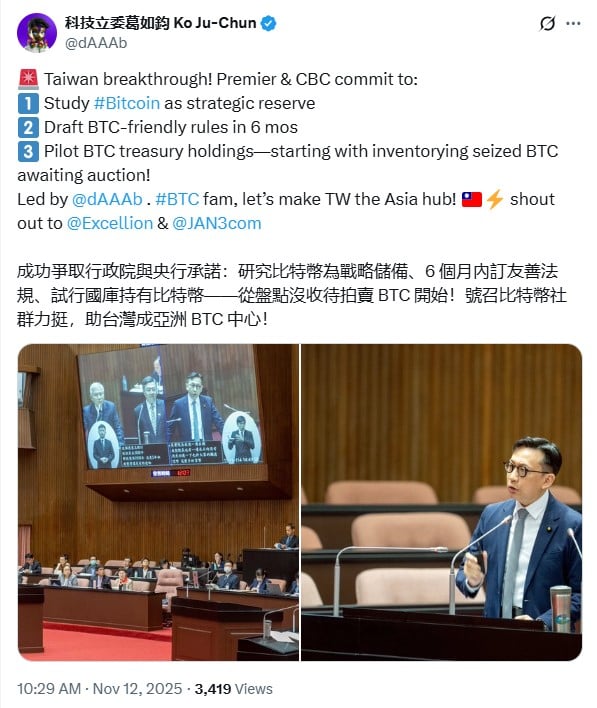Vitalik Buterin: DeFi Now Viable as Savings
Ethereum Founder Discusses Scaling Progress, Financial Freedom and Protocol Security
November 13, 2025 - Vitalik Buterin, co-founder of Ethereum, declared that decentralized finance has reached a maturity level making it viable as a savings mechanism, marking a significant milestone in blockchain technology's evolution toward mainstream financial utility. Speaking on Ethereum's scaling achievements, financial freedom potential, and protocol security enhancements, Buterin outlined how technical improvements have transformed DeFi from experimental technology into practical financial infrastructure.
DeFi as Viable Savings Mechanism
Vitalik Buterin's assertion that DeFi is "finally viable" as savings form represents dramatic shift from earlier blockchain limitations. Historical challenges including high transaction fees, network congestion, and security vulnerabilities previously prevented DeFi from serving as reliable savings vehicle.
Ethereum's scaling improvements through Layer 2 solutions have reduced transaction costs to levels making small-balance savings accounts economically feasible. Previously prohibitive gas fees that could exceed account balances for modest savers no longer present insurmountable barriers.
Yield-generating protocols in DeFi now offer competitive returns compared to traditional savings accounts, with added benefits of transparency, programmability, and global accessibility. Stablecoin-based savings products provide yield without cryptocurrency price volatility exposure.
Security improvements across DeFi protocols through auditing, formal verification, and battle-testing have increased confidence in using these platforms for longer-term value storage. Reduced hack frequency and improved incident response demonstrate sector maturation.
Ethereum Scaling Progress
Layer 2 scaling solutions including Optimistic Rollups and ZK-Rollups have increased Ethereum's effective transaction capacity by orders of magnitude. These solutions process transactions off main chain while inheriting Ethereum's security guarantees.
Transaction costs on Layer 2 networks have declined to cents or fractions of cents, compared to dollars or tens of dollars during peak congestion on Ethereum mainnet. This cost reduction makes microtransactions and small-value DeFi interactions economically viable.
Scaling roadmap progress through EIP-4844 (proto-danksharding) and future full danksharding implementations will further reduce Layer 2 costs while increasing throughput. Continuous technical improvements expand DeFi accessibility.
Cross-layer bridges and improved user experience abstractions have simplified interactions with Layer 2 networks. Users increasingly access scaled Ethereum without needing technical understanding of underlying architecture.
Financial Freedom Implications
Buterin emphasized DeFi's potential for providing financial services to unbanked and underbanked populations globally. Permissionless access removes traditional barriers including minimum balances, credit checks, and geographic restrictions.
Programmable money enabled by smart contracts allows complex financial instruments previously available only to sophisticated investors to be accessed by anyone with internet connection. Automated market makers, lending protocols, and yield optimization democratize financial sophistication.
Censorship resistance inherent in decentralized protocols protects users from arbitrary account freezes or service denial. This property proves particularly valuable for populations in jurisdictions with unstable banking systems or authoritarian governments.
Global accessibility means DeFi services remain available 24/7 without banking hours restrictions or holiday closures. This constant availability aligns with internet-native expectations and serves global user bases across time zones.
Protocol Security Evolution
Smart contract security has improved substantially through formal verification methods, comprehensive auditing practices, and accumulated operational experience. Major protocols undergo multiple independent audits before deployment.
Bug bounty programs incentivize white-hat hackers to identify vulnerabilities before malicious exploitation occurs. Substantial rewards for critical bug discovery have created professional security research ecosystem around DeFi protocols.
Insurance protocols and coverage options have emerged, allowing DeFi users to hedge smart contract risk through decentralized insurance mechanisms. Coverage availability increases user confidence for larger-value deposits.
Circuit breakers, pause mechanisms, and upgrade governance processes provide emergency response capabilities when vulnerabilities are discovered. These safety mechanisms balance immutability with security pragmatism.
Stablecoin Role in DeFi Savings
Stablecoins provide cryptocurrency benefits without price volatility that makes pure cryptocurrency unsuitable as savings vehicle. Dollar-pegged or other fiat-pegged tokens enable predictable value storage.
Yield-bearing stablecoins and stablecoin lending protocols offer returns comparable to or exceeding traditional savings accounts. Transparency regarding yield sources and risk factors exceeds traditional banking disclosure.
Regulatory clarity improvements around stablecoins in major jurisdictions have increased confidence in their viability as long-term value storage. Compliant stablecoin issuers maintain reserves and undergo auditing.
Decentralized stablecoins like DAI provide alternatives to centralized issuers, offering censorship resistance and reduced counterparty risk. Algorithmic stability mechanisms have improved through iterative development.
User Experience Improvements
Wallet interfaces have simplified dramatically, with modern applications abstracting complex blockchain interactions behind intuitive user experiences. Gas fee estimation, transaction simulation, and error prevention reduce user mistakes.
Account abstraction developments enable smart contract wallets with enhanced features including social recovery, spending limits, and automated transactions. These improvements make self-custody more accessible to non-technical users.
Fiat on-ramps and off-ramps have proliferated, making movement between traditional finance and DeFi increasingly seamless. Direct bank integration and payment processor partnerships reduce friction.
Mobile-first applications optimized for smartphones make DeFi accessible globally, particularly in regions where mobile devices represent primary internet access. Simplified mobile experiences drive adoption beyond cryptocurrency enthusiasts.
Regulatory Landscape Impact
Evolving regulatory frameworks in major jurisdictions have provided clarity reducing uncertainty that previously deterred mainstream DeFi adoption. Clear rules enable compliant protocol development and operation.
Some jurisdictions have embraced innovation-friendly regulations balancing consumer protection with fostering technological development. Regulatory sandboxes and explicit DeFi guidance demonstrate governmental engagement.
Know-your-customer and anti-money laundering requirements have been integrated into some DeFi protocols through optional compliance layers. These features enable institutional participation while preserving permissionless core functionality.
Securities regulation clarity around DeFi tokens and governance mechanisms has reduced legal uncertainty. Protocols increasingly structure offerings to avoid securities designation or embrace compliance requirements.
Traditional Finance Comparison
DeFi savings yields often exceed traditional bank savings account rates, particularly in low interest rate environments. Transparency regarding yield sources allows informed risk assessment impossible with opaque bank operations.
24/7 liquidity in DeFi contrasts with traditional banking where large withdrawals may require advance notice or face restrictions. Immediate access to funds provides flexibility valuable to savers.
Programmable automation in DeFi enables sophisticated strategies including automatic yield optimization and rebalancing. Traditional banking requires manual management or expensive professional advisory services for comparable functionality.
However, traditional banking provides government deposit insurance protecting against institution failure, whereas DeFi users bear smart contract and protocol risk. This risk-return tradeoff requires careful consideration.
Technical Challenges Remaining
Despite substantial progress, technical challenges persist. Bridge security between Layer 1 and Layer 2 networks remains vulnerable, with several high-profile bridge hacks demonstrating attack vectors.
User experience complexity still exceeds traditional banking, particularly regarding private key management and transaction confirmation. Lost private keys result in permanent fund loss without recovery mechanisms available in traditional finance.
Smart contract composability creates interdependencies where vulnerabilities in one protocol can cascade through integrated systems. This complexity increases systemic risk requiring ongoing vigilance.
Scalability improvements, while substantial, still face limitations during extreme usage spikes. Further technical development remains necessary for handling global-scale financial activity.
Institutional Adoption Indicators
Traditional financial institutions increasingly explore DeFi integration through pilot programs and strategic investments. Banks develop blockchain-based services inspired by DeFi innovation.
Asset managers create investment products providing client exposure to DeFi yields. These structured products make DeFi returns accessible to investors uncomfortable with direct protocol interaction.
Corporate treasuries explore DeFi for cash management, seeking higher yields than traditional instruments while maintaining liquidity. Stablecoin-based solutions attract corporate financial officers.
Payment processors integrate DeFi infrastructure for settlement and liquidity management. Traditional finance and DeFi convergence accelerates as technical barriers diminish.
Decentralization and Security Tradeoffs
Achieving sufficient decentralization while maintaining usability and performance requires careful balance. Some protocols have sacrificed decentralization for user experience or speed.
Multi-signature controls and governance mechanisms introduce centralization vectors potentially compromising censorship resistance. Protocol designers navigate tradeoffs between security, decentralization, and efficiency.
Upgradeability mechanisms allowing bug fixes and improvements create admin key risks. Timelocks, multi-party control, and eventual immutability represent approaches to managing upgrade risks.
Governance token distribution concentration means small holder groups sometimes control protocol direction. Improving governance decentralization remains ongoing challenge for DeFi projects.
Global Accessibility Impact
DeFi removes geographic barriers allowing global participation in identical financial services. A user in developing nation accesses same protocols as sophisticated investor in financial center.
Currency controls and capital restrictions become less effective when citizens can access global DeFi markets. This dynamic creates tension between governments and borderless protocols.
Remittance use cases demonstrate DeFi's practical value for international money transfer. Lower fees and faster settlement compared to traditional remittance services provide tangible benefits.
However, internet access and smartphone availability remain prerequisites limiting DeFi accessibility in least developed regions. Infrastructure development must accompany protocol improvements.
Risk Management and Education
User education regarding smart contract risks, impermanent loss, and protocol vulnerabilities remains critical for sustainable DeFi adoption. Unrealistic yield expectations can lead to poor decisions.
Risk disclosure and transparency improvements help users make informed decisions. Protocol documentation, audit reports, and risk parameter clarity enable better risk assessment.
Simulation tools and education platforms teach users about DeFi mechanics before committing funds. Testnet environments allow risk-free experimentation.
Community-driven education initiatives and improved protocol documentation reduce knowledge barriers. However, financial literacy requirements still exceed traditional banking.
Future Development Roadmap
Continued scaling improvements through sharding and Layer 2 advancement will further reduce costs and increase capacity. Technical roadmap execution remains critical for DeFi's savings viability expansion.
Privacy enhancements through zero-knowledge proofs could enable confidential transactions while maintaining public verifiability. Privacy improvements would address user concerns about financial surveillance.
Cross-chain interoperability developments may create unified DeFi ecosystem spanning multiple blockchains. Seamless multi-chain experiences would expand available services and liquidity.
Regulatory compliance tooling and optional identity layers could enable institutional adoption while preserving permissionless core functionality. Hybrid approaches may serve diverse user needs.
Conclusion
Vitalik Buterin's declaration that DeFi has become viable as savings mechanism marks significant milestone in blockchain technology's maturation journey. Technical improvements in Ethereum scaling, particularly Layer 2 development reducing transaction costs, have addressed economic feasibility barriers that previously prevented DeFi from serving ordinary savers. Security enhancements through improved auditing, formal verification, and accumulated operational experience have reduced protocol vulnerability risks. The combination of competitive yields, global accessibility, programmable automation, and censorship resistance creates compelling value proposition compared to traditional savings accounts, particularly for unbanked populations and users in jurisdictions with unstable banking systems. However, challenges remain including user experience complexity, smart contract risks, regulatory uncertainty, and technical limitations requiring ongoing development. The risk-return tradeoff between DeFi's higher potential yields and lack of government deposit insurance requires careful individual assessment. Traditional finance and DeFi are converging as banks explore blockchain integration and DeFi protocols add compliance features. Buterin's comments reflect confidence in Ethereum's technical trajectory and DeFi's readiness for mainstream financial inclusion, suggesting the sector has evolved from experimental technology to practical infrastructure. The ultimate test of DeFi as viable savings mechanism will come through sustained adoption by non-cryptocurrency-native users seeking financial services rather than speculative investment. As protocols mature, user experiences simplify, and regulatory frameworks clarify, DeFi's role in global financial system likely will expand substantially, potentially fulfilling blockchain technology's promise of democratized financial access.
You May Also Like

Satoshi-Era Mt. Gox’s 1,000 Bitcoin Wallet Suddenly Reactivated

Taiwan to Pilot Bitcoin Treasury Holdings Using Seized BTC
